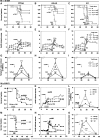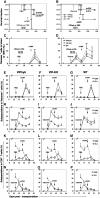Pharmacological inhibition of VIP signaling enhances antiviral immunity and improves survival in murine cytomegalovirus-infected allogeneic bone marrow transplant recipients
- PMID: 23325838
- PMCID: PMC3606069
- DOI: 10.1182/blood-2012-06-437640
Pharmacological inhibition of VIP signaling enhances antiviral immunity and improves survival in murine cytomegalovirus-infected allogeneic bone marrow transplant recipients
Abstract
Cytomegalovirus (CMV) infection following allogeneic bone marrow transplant (allo-BMT) is controlled by donor-derived cellular immunity. Vasoactive intestinal peptide (VIP) suppresses Th1 immunity. We hypothesized that blocking VIP-signaling would enhance anti-CMV immunity in murine recipients of allo-BMT. Recipients were transplanted with bone marrow (BM) and T-cells from major histocompatibility complex (MHC)-mismatched VIP-knockout (KO) or wild-type donors, and treated with 7 daily subcutaneous injections of VIPhyb (peptidic VIP-antagonist) or phosphate-buffered saline (PBS). Genetic and pharmacological blockade of VIP-signaling protected allo-BMT recipients from lethal murine CMV (mCMV) infection, improving survival without increasing graft-versus-host disease. Mice treated with VIPhyb or transplanted with VIP-KO allografts had significantly lower viral loads, increased numbers of mCMV-M45-peptide-MHC-tetramer(+) CD8(+) T-cells, with lower PD-1 expression, and enhanced primary and secondary cellular immune responses after mCMV infection than did PBS-treated mice. These results demonstrate that administration of a VIP antagonist after allo-BMT is a promising safely therapeutic approach to enhance antiviral cellular immunity.
Figures


Similar articles
-
Modulation of Immune Checkpoints and Graft-versus-Leukemia in Allogeneic Transplants by Antagonizing Vasoactive Intestinal Peptide Signaling.Cancer Res. 2016 Dec 1;76(23):6802-6815. doi: 10.1158/0008-5472.CAN-16-0427. Epub 2016 Sep 26. Cancer Res. 2016. PMID: 27671676 Free PMC article.
-
VIPhyb, an antagonist of vasoactive intestinal peptide receptor, enhances cellular antiviral immunity in murine cytomegalovirus infected mice.PLoS One. 2013 May 27;8(5):e63381. doi: 10.1371/journal.pone.0063381. Print 2013. PLoS One. 2013. PMID: 23723978 Free PMC article.
-
Absence of vasoactive intestinal peptide expression in hematopoietic cells enhances Th1 polarization and antiviral immunity in mice.J Immunol. 2011 Jul 15;187(2):1057-65. doi: 10.4049/jimmunol.1100686. Epub 2011 Jun 15. J Immunol. 2011. PMID: 21677142 Free PMC article.
-
Allogeneic T cells treated with amotosalen prevent lethal cytomegalovirus disease without producing graft-versus-host disease following bone marrow transplantation.J Immunol. 2003 Dec 1;171(11):6023-31. doi: 10.4049/jimmunol.171.11.6023. J Immunol. 2003. PMID: 14634114
-
Murine cytomegalovirus immune evasion proteins operative in the MHC class I pathway of antigen processing and presentation: state of knowledge, revisions, and questions.Med Microbiol Immunol. 2012 Nov;201(4):497-512. doi: 10.1007/s00430-012-0257-y. Epub 2012 Sep 9. Med Microbiol Immunol. 2012. PMID: 22961127 Review.
Cited by
-
Modulation of Immune Checkpoints and Graft-versus-Leukemia in Allogeneic Transplants by Antagonizing Vasoactive Intestinal Peptide Signaling.Cancer Res. 2016 Dec 1;76(23):6802-6815. doi: 10.1158/0008-5472.CAN-16-0427. Epub 2016 Sep 26. Cancer Res. 2016. PMID: 27671676 Free PMC article.
-
[Expression of vasoactive intestinal peptide in peripheral blood of children with hand, foot and mouth disease].Zhongguo Dang Dai Er Ke Za Zhi. 2016 Nov;18(11):1106-1110. doi: 10.7499/j.issn.1008-8830.2016.11.010. Zhongguo Dang Dai Er Ke Za Zhi. 2016. PMID: 27817774 Free PMC article. Chinese.
-
The magic of small-molecule drugs during ex vivo expansion in adoptive cell therapy.Front Immunol. 2023 Apr 21;14:1154566. doi: 10.3389/fimmu.2023.1154566. eCollection 2023. Front Immunol. 2023. PMID: 37153607 Free PMC article. Review.
-
Recombinant TLR5 agonist CBLB502 promotes NK cell-mediated anti-CMV immunity in mice.PLoS One. 2014 May 30;9(5):e96165. doi: 10.1371/journal.pone.0096165. eCollection 2014. PLoS One. 2014. PMID: 24879439 Free PMC article.
-
VIPhyb, an antagonist of vasoactive intestinal peptide receptor, enhances cellular antiviral immunity in murine cytomegalovirus infected mice.PLoS One. 2013 May 27;8(5):e63381. doi: 10.1371/journal.pone.0063381. Print 2013. PLoS One. 2013. PMID: 23723978 Free PMC article.
References
-
- Delgado M, Gonzalez-Rey E, Ganea D. The neuropeptide vasoactive intestinal peptide generates tolerogenic dendritic cells. J Immunol. 2005;175(11):7311–7324. - PubMed
-
- Delgado M, Pozo D, Ganea D. The significance of vasoactive intestinal peptide in immunomodulation. Pharmacol Rev. 2004;56(2):249–290. - PubMed
-
- Gomariz RP, Delgado M, Naranjo JR, et al. VIP gene expression in rat thymus and spleen. Brain Behav Immun. 1993;7(4):271–278. - PubMed
Publication types
MeSH terms
Substances
Grants and funding
LinkOut - more resources
Full Text Sources
Other Literature Sources
Medical
Molecular Biology Databases
Research Materials

